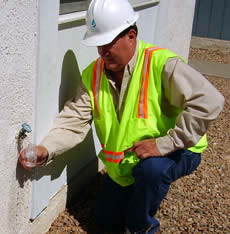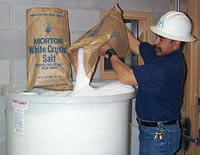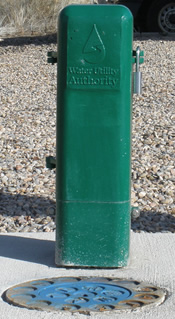While some regulatory compliance monitoring is required at entry points, other monitoring must be completed in the distribution system.
Samples for testing of microbiological contaminants, disinfection by-products, and disinfectants are collected throughout the distribution system.

Taking Samples in the Distribution System
Results of Microbiological Testing in the Distribution System
The Safe Drinking Water Act requires water systems to meet standards for total coliform and E. coli bacteria. Because most water systems in the United States disinfect their water supplies, waterborne diseases caused by bacteria are rare in this country.
Each month, samples are collected from sample points throughout the distribution system and tested for total and fecal coliform bacteria. Many customers have allowed us to use water taps at their homes and businesses to collect samples. In 2024, over 2,900 samples were collected and tested for total coliform and E. coli bacteria.
| Monthly Monitoring | ||||
| Distribution System Samples | Maximum Detection | Maximum Contaminant Level (MCL) | MCL Goal (MCLG) | Source |
| Total Coliform (242 samples each month) |
0 of 242 samples or 0% of samples taken in a month had detectable total coliform bacteria | Presence of coliform bacteria in 5.0% or more of samples in any month. | 0% of samples with detectable coliform bacteria. | Coliforms are bacteria that are normally present in the environment. |
Results of Disinfection Byproduct Testing in the Distribution System
During disinfection, disinfection byproducts form as a result of chemical reactions between chlorine and naturally occurring organic matter in the water. USEPA has set standards for two kinds of disinfection byproducts: Total Trihalomethanes and Haloacetic Acids.
The New Mexico Environment Department (NMED) has directed the Water Authority to collect one sample every three months at twelve locations in the distribution system. Each sample is tested for Total Trihalomethanes and Haloacetic Acids. The results for the entire distribution system for 2024 are shown below.
| Quarterly Monitoring | |||||
| Distribution System Samples | Range of Results | Maximum Detected | Maximum Contaminant Level (MCL) | MCL Goal (MCLG) | Source |
| Total Trihalomethanes1 (TTHMs) | 2.2-41 PPB3 | 38.8 PPB (highest LRAA4 at site 1) | 80 PPB | N/A | By-product of chlorination |
| Haloacetic Acid2 (HAA5s) | 0 – 19 PPB3 | 16.6 PPB (highest LRAA4 at site 1) | 60 PPB | N/A | By-product of chlorination |
|
PPB = Parts Per Billion N/A = Not Applicable
1 TTHMs are the sum of the concentrations of the trihalomethane compounds. 2 HAA5s are the sum of the concentrations of the haloacetic acid compounds. 3 The range represents the minimum and maximum of all quarterly analytical results at all 12 locations. 4 The Locational Running Annual Average (LRAA) is the average of sample analytical results for samples taken at a particular monitoring location during the previous four calendar quarters. |
|||||
Results of Disinfectant Testing in the Distribution System

Utility Tech Adding Salt to Brine Tank
The water supply is disinfected with sodium hypochlorite. Generated on-site from table salt and water, sodium hypochlorite is like weak household bleach.
Each time a sample for microbiological testing is collected, the level of chlorine in the sample is measured.
| Monthly Monitoring | ||||||
| Distribution System Samples | Minimum Detected | Average Detected | Maximum Detected | Maximum Residual Disinfectant Level (MRDL) | Maximum Residual Disinfectant Level Goal (MRDLG) | Source |
| Chlorine | 0.3 PPM | 0.9 PPM | 1.7 PPM | 4 PPM | 4 PPM | Disinfectant (sodium hypochlorite) |
|
PPM = Parts Per Million
|
||||||

New Sample Hydrant
Sample Hydrants
For many years, many of you have allowed Water Quality Specialists access to water taps outside your homes for collection of water samples. We thank you. However, like the mailman or the meter reader, Water Quality Specialists often encounter difficult circumstances. A new dog, a new fence, or a broken or frozen faucet make a sample site unusable. Field Distribution crews install the sample hydrants dedicated to the collection of samples providing better quality control and easier access. The hydrants are enclosed in kelly green boxes that look much like a cable T.V. box. For more information about the sample hydrants call the Water Quality Program at 289-3653 or email waterquality@abcwua.org.

